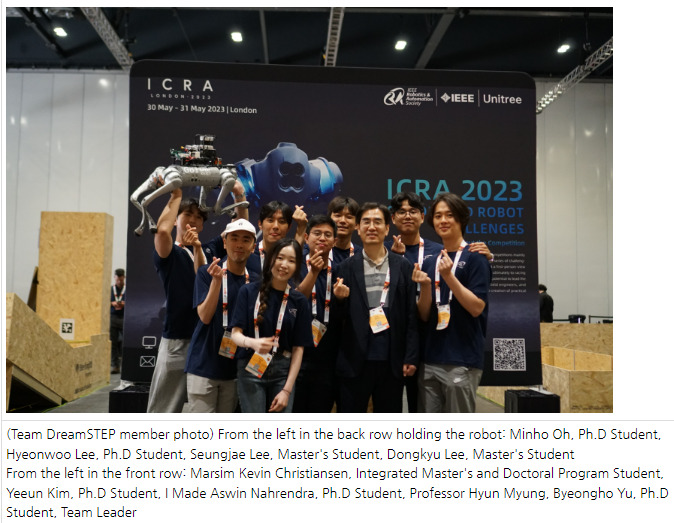Professor Myung Hyun’s research team ranks first, surpassing MIT and CMU.

– School of EE Professor Myung Hyun’s team wins the competition held at the world’s top robotics conference by building a robust autonomous walking system with their independently developed technologies.
– A successful application of complete autonomous walking in challenging environments that is not easy to quickly complete even with direct human interference (control)
– This feat is expected to be used not only in various industrial fields, but also in environments of disasters where wireless communication is limited.
Recently, the KAIST autonomous walking robot, equipped with ‘DreamWaQ’ – a walking robot controller that can briskly climb stairs without the help of separate visual or tactile sensors – has become a hot topic after winning first place at the IEEE International Conference of Robotics and Automation Quadruped Robot Challenge (QRC).
Professor Myung Hyun’s research team (Urban Robotics Lab) from the School of Electrical Engineering won the Quadruped Robot Challenge (QRC) hosted at the 2023 IEEE Conference of Robotics and Automation (IEEE ICRA), the largest academic conference in the field of robotics held in London, UK from May 29 to June 2, 2023. The team won on June 1st, local time, with a dominating performance.
This KAIST team independently developed and systematically integrated and optimized their technology, successfully demonstrating autonomous walking at QRC, where a total of 11 teams from around the world (including Korea, the United States, Hong Kong, Italy, and France) and 7 teams advanced to the main round. They scored a total of 246 points in the final round in which six teams participated. This score beats the 60 points earned by the Massachusetts Institute of Technology (MIT) by more than fourfold, essentially securing the KAIST team’s victory with an overwhelming difference (1st place: KAIST, Team DreamSTEP, 2nd place: MIT, 3rd place: Carnegie Mellon University (CMU)).
It is also worth noting that the KAIST team used a small quadruped walking robot, but it moved the fastest and scored the highest. In the finals, teams primarily using remote manual control recorded an average completion time of about 49 minutes, while the KAIST team recorded a completion time of 41 minutes and 52 seconds primarily through autonomous walking (the second-place MIT team took 45 minutes and 32 seconds using a remote control). The winning KAIST team was awarded a walking robot worth about 20 million won and is expected to receive a subsidy worth about 3 million won.
Professor Myung Hyun of KAIST stated, “All the technologies that allow us to perceive the environment around the robot and find appropriate paths, not just those limited to the controller used for ‘DreamWaQ’, were independently developed by our research team. We expect this technology will contribute to enhancing the competitiveness of the domestic robotics industry.”

Related Press :
Chosun Media : KAIST가 MIT 눌렀다… 사족보행 국제 로봇 대회서 1등 (chosun.com)
DongA Media : KAIST 자율보행로봇, MIT 제치고 세계 1위|동아일보 (donga.com)